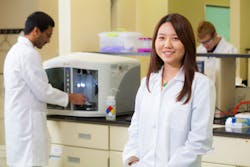FAYETTEVILLE, AR, JAN 15, 2018 -- Environmental engineers have discovered that Chlorella vulgaris, a single-celled fresh water algae species, effectively removes pollutants from wastewater even at fluctuating levels, making it an effective tool for wastewater treatment.
The study, published recently in Water Environment Research, indicates that Chlorella vulgaris continues to remove harmful elements like nitrogen and phosphorous from wastewater even after one type of pollutant is depleted. Some algae require both nitrogen and phosphorous to be present to function, which can limit its effectiveness in wastewater treatment.
"One of the factors that significantly impacts algal wastewater treatment is nutrient availability," said Wen Zhang, associate professor in the Department of Civil Engineering. "What is the ideal range of nitrogen-to-phosphrous mass ratio for algal growth? Because previous research failed to identify this, the efficacy of algal treatment has been difficult to predict or optimize."




